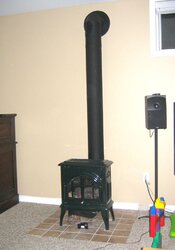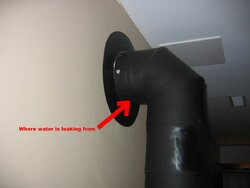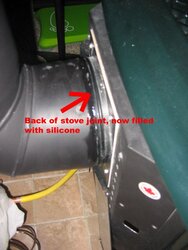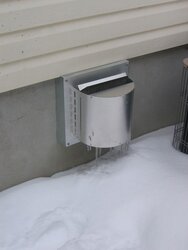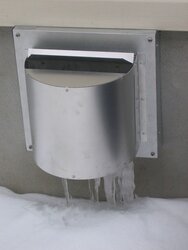I recently installed a Enviro Ascot direct vent gas gas stove in my basement. Everything is hunky dory, except for one issue: water condensation leaking from the exhaust pipe.
I've used ICC ExcelDirect 5" piping, 4.5' up, then a 90 degree out through the wall.
What is happening is, when the stove is off, (with the pilot either on or off), then turned back on, water will run out of the inside of the 90 elbow once the stove is relighted.
Obviously I have an air leak somewhere that is causing warm moist air to condensate and freeze on the inside of the pipe(s). When the piping warms, the ice melts and runs out the joint.
The trouble is, I can't figure out where it's leaking. Initially I thought it was being caused by the lack of good seal on the exterior of the pipe at the stove. (It being the lowest, and best point for convection to take place from.) I slathered on the RTV on that joint, but it did nothing.
We've had some rather frigid nights here in southern Ontario (-28C ) the last little while, so the condensation has been rather voluminous.
Has any one experienced this, and do you have any suggestions as to how to remedy this? I'm to the point where I want to disassemble the piping and coat all the joints, inside and out with RTV....
I've used ICC ExcelDirect 5" piping, 4.5' up, then a 90 degree out through the wall.
What is happening is, when the stove is off, (with the pilot either on or off), then turned back on, water will run out of the inside of the 90 elbow once the stove is relighted.
Obviously I have an air leak somewhere that is causing warm moist air to condensate and freeze on the inside of the pipe(s). When the piping warms, the ice melts and runs out the joint.
The trouble is, I can't figure out where it's leaking. Initially I thought it was being caused by the lack of good seal on the exterior of the pipe at the stove. (It being the lowest, and best point for convection to take place from.) I slathered on the RTV on that joint, but it did nothing.
We've had some rather frigid nights here in southern Ontario (-28C ) the last little while, so the condensation has been rather voluminous.
Has any one experienced this, and do you have any suggestions as to how to remedy this? I'm to the point where I want to disassemble the piping and coat all the joints, inside and out with RTV....


